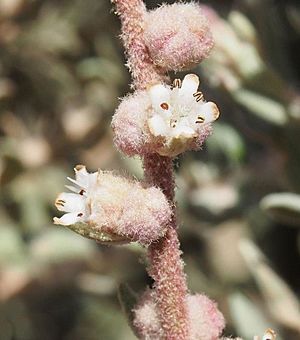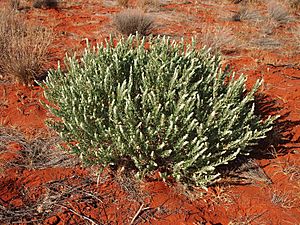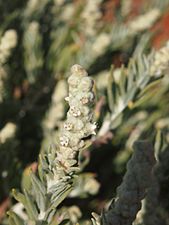Dicrastylis costelloi facts for kids
Quick facts for kids Dicrastylis costelloi |
|
|---|---|
 |
|
| Scientific classification | |
 |
|
| Synonyms | |
|
Dicrastylis costelloi var. eriantha (F.Muell.) Munir |
Dicrastylis costelloi is a type of flowering plant. It belongs to the group of plants called Dicrastylis. This plant is part of the Lamiaceae family, which also includes mint.
You can find Dicrastylis costelloi growing in several parts of Australia. These areas include Western Australia, South Australia, the Northern Territory, and Queensland.
What Does It Look Like?
Dicrastylis costelloi is a small bush, also known as a shrub. It usually grows to about 40 centimeters (about 16 inches) tall. This plant likes to grow in red sandy soil.
Its stems are mostly round. They do not have any special flat scales. The leaves grow in pairs, one on each side of the stem. They are usually 8 to 25 millimeters long and 3.2 to 6 millimeters wide. These leaves have tiny, branched hairs on them.
Flowers
The flowers of Dicrastylis costelloi do not have stalks; they sit directly on the stem. There are small, leaf-like parts near the flowers called bracteoles (1-2 mm long) and bracts (5-9 mm long).
The outer part of the flower, called the calyx, has five parts. These parts are about 1.5 millimeters long and are covered in tiny hairs. The petals, known as the corolla, are white or cream in color. They are about 4.5 to 5 millimeters long. The center of the flower does not have any dots or stripes. Each flower has five stamens, which are the parts that produce pollen. In Western Australia, this plant usually flowers in October.
How It Got Its Name
The plant Dicrastylis costelloi was first officially described in 1891. It was named by a scientist named Frederick Manson Bailey.
The name costelloi was chosen to honor M. Costello. M. Costello collected the first plant specimen used for its description. This specimen was found near Lake Nash. Lake Nash is on the border between Queensland and the Northern Territory of South Australia. Another original sample, called an isotype, is kept at the British Museum.
Gallery




